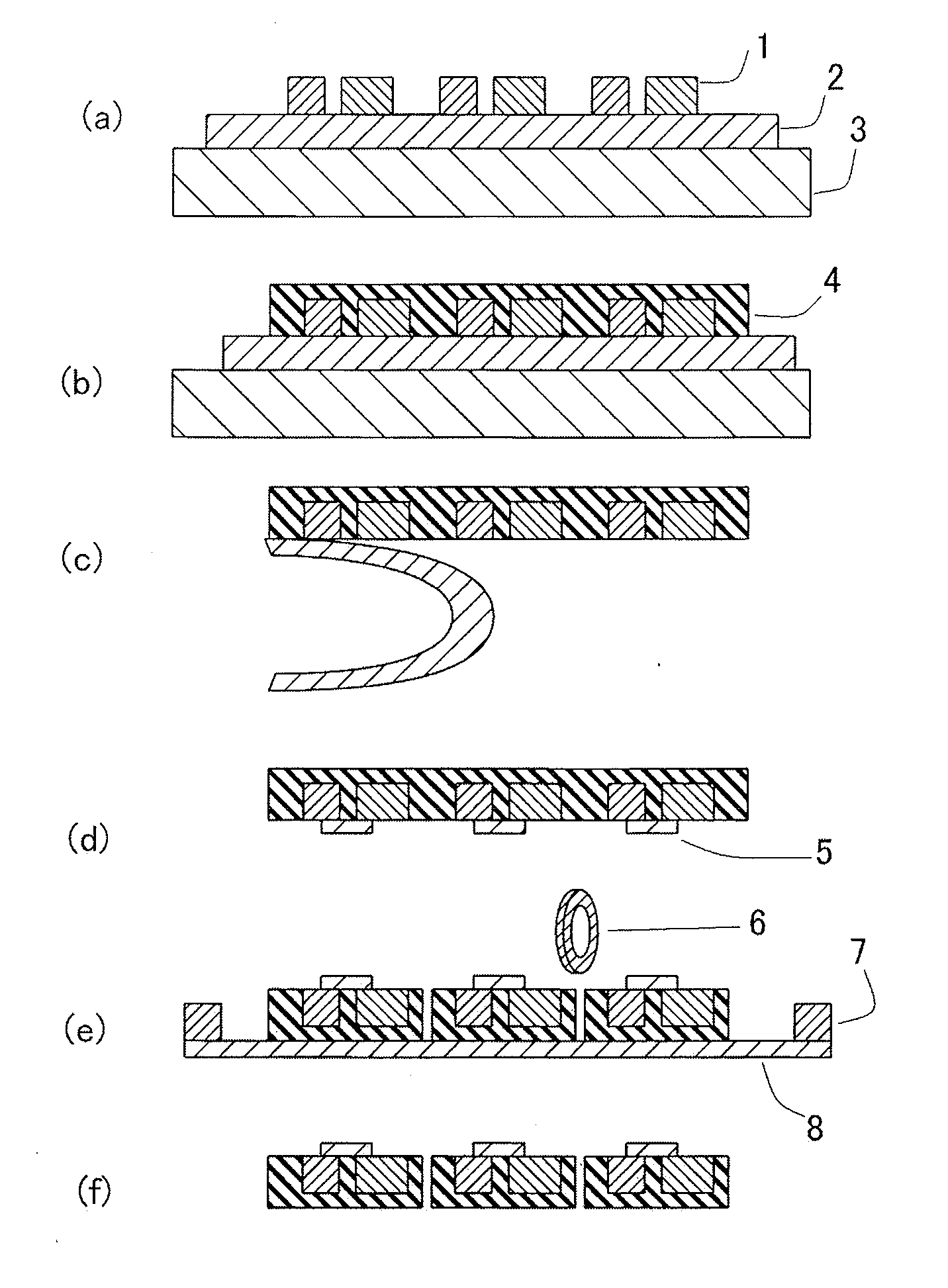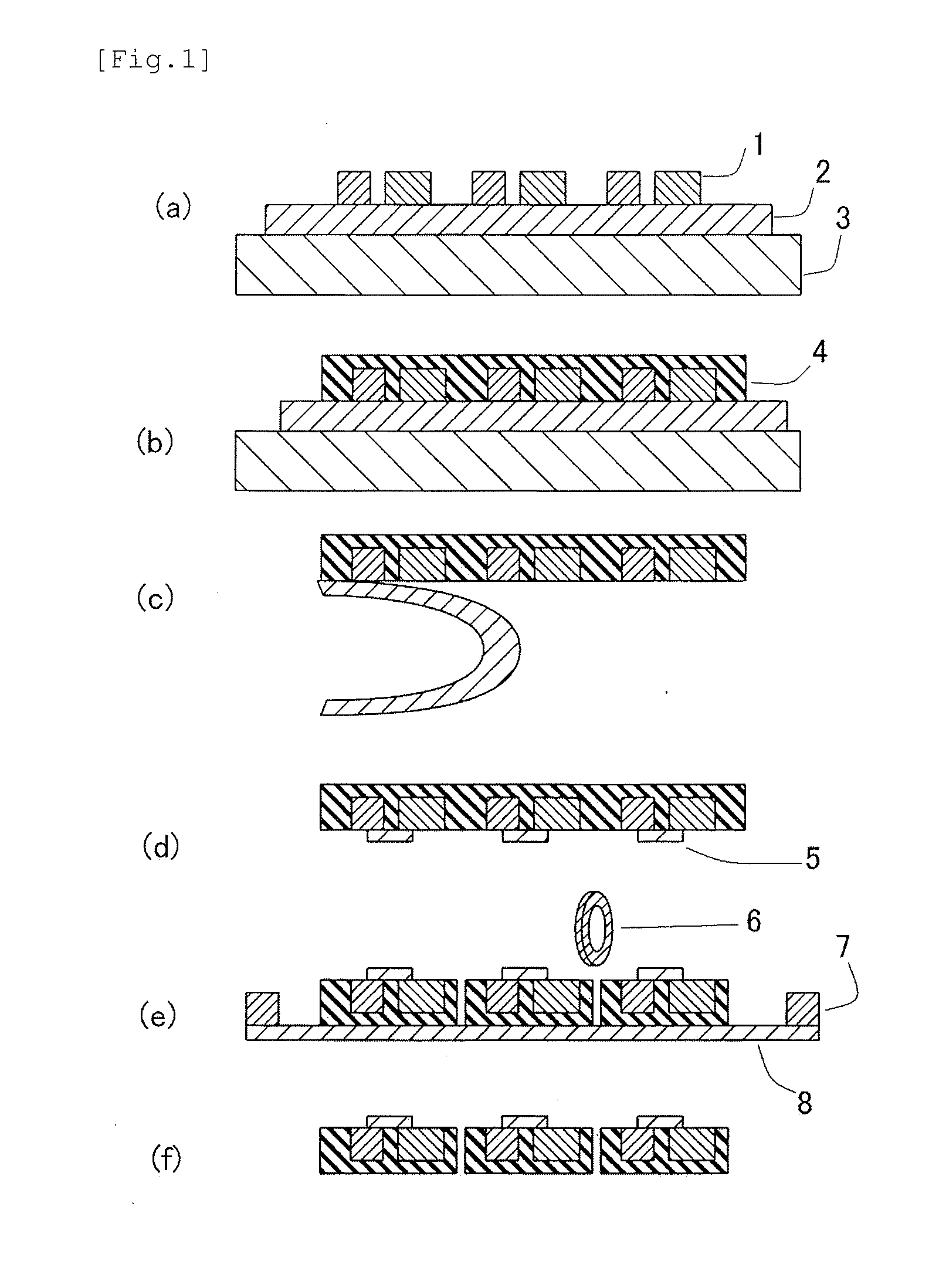Heat-resistant adhesive sheet for semiconductor device fabrication, adhesive used for the sheet, and method for fabricating semiconductor device using the sheet
a technology of heat-resistant adhesive and semiconductor devices, which is applied in the directions of film/foil adhesives, semiconductor/solid-state device details, transportation and packaging, etc., can solve the problems of difficult peeling off of heat-resistant adhesive sheets, the method is not intended for substrateless semiconductor devices, and the subsequent electrode formation step is not smooth. achieve the effect of improving the fabrication yield of semiconductor packages
- Summary
- Abstract
- Description
- Claims
- Application Information
AI Technical Summary
Benefits of technology
Problems solved by technology
Method used
Image
Examples
working examples
[0087]A measuring method used in working examples is as follows.
[0088]Initial adhesion strength to SUS: Peel adhesion strength to a SUS304BA plate at an angle of 180° at room temperature
[0089]Peel strength from package: Peel adhesion strength at an angle of 180° when the adhesive tape is peeled from the package
[0090]Chip displacement: Displacement from the initial position of a chip measured with a digital microscope after package fabrication
[0091]Adhesive deposit: The surface of the package was visually checked for adhesive deposits after the adhesive tape was peeled off.
[0092]The present invention will be descried more specifically with respect to working examples. The term “part” in the following description means “part by weight”.
working example 1
[0093]42 parts of acrylonitrile-butadiene rubber (Nipol 1072) from Zeon Corporation), 53 parts of bisphenol A-type epoxy resin (Epikote 828 from Japan Epoxy Resin Co., Ltd., with a weight per epoxy equivalent of 190 g / eq), and 5 parts of imidazole (C1 1Z from Shikoku Chemicals Corporation) were blended and dissolved in an MEK solvent to a concentration of 35 wt % to prepare a bond solution. The bond solution was applied to a 35-μm-thick copper foil serving as a base material film, and was then dried at 150° C. for 3 minutes to form an adhesive layer having a thickness of 10 μm, thus forming a heat-resistant adhesive sheet for semiconductor device fabrication.
[0094]A 3 mm×3 mm Si wafer chip was placed on the heat-resistant adhesive tape, epoxy-based encapsulation resin powder (GE-740LA from Nitto Denko Corporation) was sprinkled over the tape and the wafer chip, and then molded by heating at a temperature of 175° C. under a pressure of 3.0 kg / cm2 for 2 minutes. Then the structure was...
working example 2
[0095]24 parts of acrylonitrile-butadiene rubber (Nipol 1072) from Zeon Corporation), 65 parts of bisphenol A-type epoxy resin (Epikote 1002 from Japan Epoxy Resin Co., Ltd., with a weight per epoxy equivalent of 650 g / eq), 10 parts of phenol resin (P-180 from Arakawa Chemical Industries, Ltd.), and 1 part of triphenylphosphane (TPP from Hokko Chemical Industry) were blended and dissolved in an MEK solvent to a concentration of 35 wt % to prepare an adhesive solution. The adhesive solution was applied to a 35-μm-thick copper foil serving as the base material film, and was then dried at 150° C. for 3 minutes to form an adhesive layer having an adhesive thickness of 10 μm, thus forming a heat-resistant adhesive sheet for semiconductor device fabrication. The rest of the method for fabricating the package was the same as that in Working Example 1.
PUM
| Property | Measurement | Unit |
|---|---|---|
| temperatures | aaaaa | aaaaa |
| temperature | aaaaa | aaaaa |
| glass transition temperature | aaaaa | aaaaa |
Abstract
Description
Claims
Application Information
 Login to View More
Login to View More - R&D
- Intellectual Property
- Life Sciences
- Materials
- Tech Scout
- Unparalleled Data Quality
- Higher Quality Content
- 60% Fewer Hallucinations
Browse by: Latest US Patents, China's latest patents, Technical Efficacy Thesaurus, Application Domain, Technology Topic, Popular Technical Reports.
© 2025 PatSnap. All rights reserved.Legal|Privacy policy|Modern Slavery Act Transparency Statement|Sitemap|About US| Contact US: help@patsnap.com



